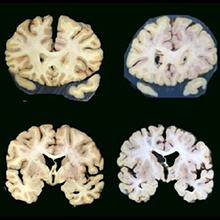14 June 2023

It has long been known that people who have had traumatic brain injury with loss of consciousness have an increased risk of dementia. But it has been debated whether the increased risk was due to brain changes like those seen with Alzheimer’s disease and related dementias or some other process.
Now a new autopsy study from researchers at the University of Washington School of Medicine, Mount Sinai School of Medicine, and Kaiser Permanente Health Research Institute has found that people who reported having lost consciousness after sustaining a traumatic brain injury faced a higher risk of brain atrophy, but not the changes associated with Alzheimer’s and related dementias. Brain atrophy is a loss of brain nerve cells and the connections between them. This often leads to decreased brain volume.
“Our finding adds to a growing body of research that suggests the pathological processes underlying post-traumatic neurodegeneration are distinct from those seen with Alzheimer’s disease,” said Laura Gibbons, a senior research scientist at the UW School of Medicine’s Department of Internal Medicine and lead author on the study. The article was published online in the Journal of Alzheimer’s Disease in April.
In their study, the UW Medicine researchers and their colleagues compared the brains of people who reported having had head trauma with loss of consciousness with those of people who reported never having such an injury. The brains were donated by participants in a Seattle study of brain aging and dementia called the Adult Changes in Thought study. Participants in the ACT study were members of Kaiser Permanente Washington in the Seattle area who were randomly selected to be invited to participate. To qualify, they had to be 65 or older, living in the community and not have dementia.
At the time of enrollment and every two years thereafter, the participants underwent detailed health and cognitive assessments until they either died, developed dementia or dropped out. As part of their assessments, information was gathered from the participants, their medical records and, in the event of their death or the onset of dementia, from interviews with family and friends. The focus was the participant’s history of head trauma, including whether it was accompanied by loss of consciousness, which can occur with more severe head trauma.
Examination of the participants' donated brains did not find more of the changes seen with Alzheimer’s disease and related dementias, such as amyloid plaques, in those who had brain injury with loss of consciousness. But they did find that those who had experienced head trauma with loss of consciousness were more likely to have brain atrophy.
The increase in risk for brain atrophy was small, or about 22%, ”but it was statistically significant, so it’s likely real," noted C. Dirk Keene, the Nancy and Buster Alvord Endowed Chair in Neuropathology and professor of laboratory medicine and pathology at the UW School of Medicine, whose team examined the brains. The cause of brain atrophy in these individuals is unknown, Keene said.
“We typically see atrophy as the downstream consequence of many other forms of neuropathology,” said Keene. “Strokes can cause atrophy, Alzheimer's-type neuropathological changes like amyloid plaques can cause atrophy, and so on. But we looked for everything else and did not find any other clear associations with TBI—just atrophy itself. Atrophy is also a consequence of the diffuse injury to axons commonly seen after brain injury, so this finding supports axonal injury as a contributor to post-traumatic neurodegeneration. We still have a lot to figure out."
The research was funded by the National Institute on Aging (U19AG066567, U01AG006781, P30 AG066509, pP50AG05136, AG0610280), the National Institutes of Neurological Disorders and Stroke (U01NS086625-01), the Department of Defense Congressionally Directed Medical Research Program (W81XWH-17-1-0330), and the Nancy and Buster Alvord Endowment.
Figure Caption: Brain on left is without significant atrophy. Larger spaces in brain on right indicate atrophy. Credit: Lisa Keene, UW School of Medicine
This news item was written by Michael McCarthy.
Media contact: Susan Gregg, sghanson@uw.edu, 206.390.3226







